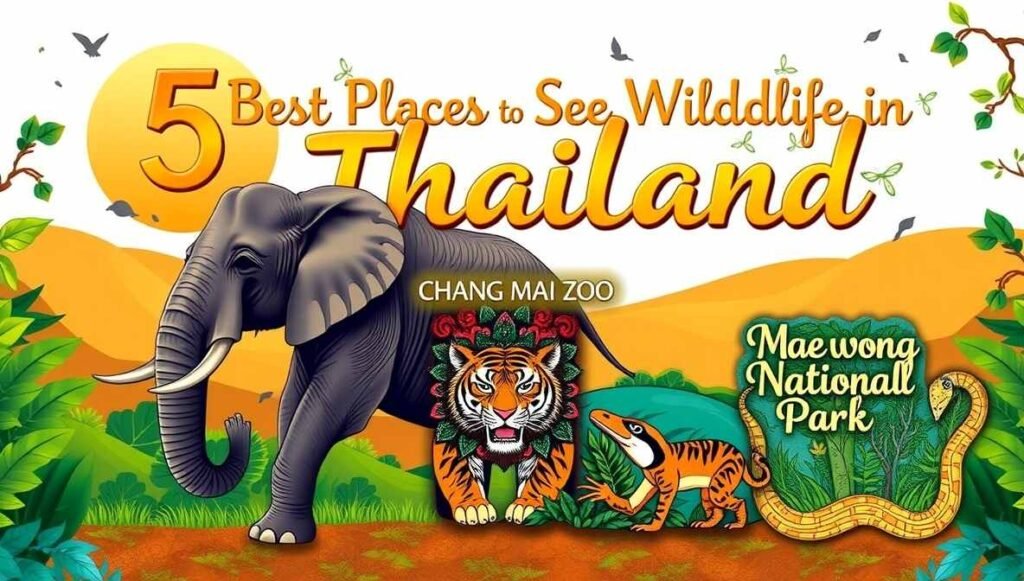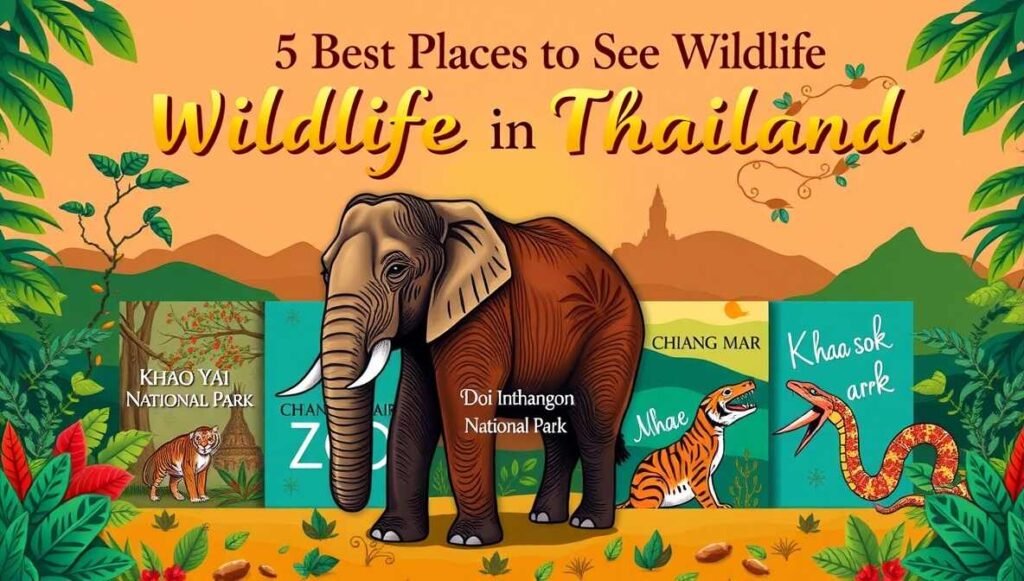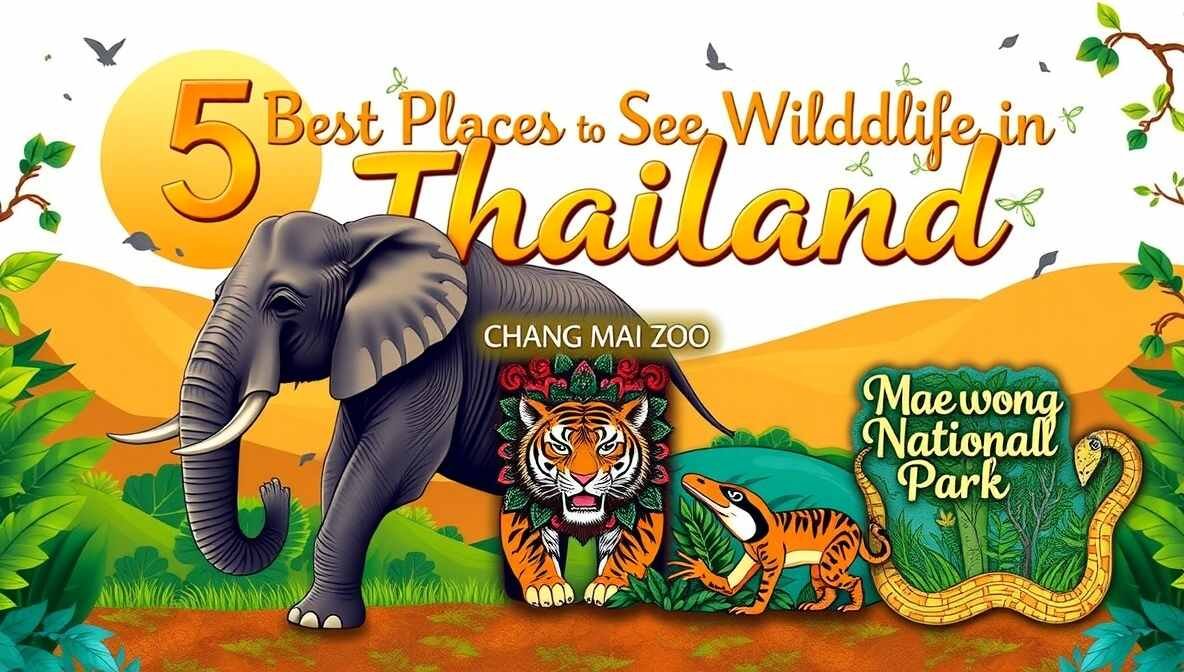Thailand, with its lush jungles, sparkling coastlines, and vibrant biodiversity, is a paradise for wildlife enthusiasts. Known as the “Land of Smiles,” this Southeast Asian nation offers unparalleled opportunities to encounter animals in their natural habitats. From majestic elephants roaming national parks to rare birds hidden among mangroves, Thailand is truly one of the best places to see wildlife in Thailand.
Whether you’re trekking through dense tropical rainforests or exploring the crystal-clear waters of its marine parks, Thailand’s unique combination of ecosystems ensures wildlife encounters that will leave you in awe.

Why Thailand Is the Best Place to See Wildlife
Thailand’s natural diversity is unmatched, encompassing tropical forests, mangroves, coral reefs, and mountain ranges. Home to over 10% of the world’s animal species, it boasts elephants, tigers, gibbons, and a dazzling array of birds and marine life. The country’s national parks and wildlife sanctuaries span millions of hectares, making these protected areas a haven for nature lovers.
Conservation is a growing priority in Thailand, with efforts to protect endangered species like the Asian elephant, Indochinese tiger, and various marine creatures. Eco-tourism initiatives have also improved awareness about sustainable wildlife experiences, earning Thailand recognition as one of the top wildlife spots in Thailand.
Top Wildlife Spots in Thailand
1. Khao Yai National Park
This UNESCO World Heritage Site is Thailand’s oldest and one of its most famous national parks. Located just three hours from Bangkok, the park’s forests and grasslands are home to elephants, gibbons, hornbills, and leopards. Hike its many trails or visit watchtowers for chances to see wildlife in action.
2. Erawan National Park
Famous for its stunning Erawan Falls, this forested paradise in western Thailand offers chances to spot langurs, monitor lizards, and an array of bird species. Its emerald pools also attract fish and amphibians, making it ideal for nature photography.
3. Khao Sok National Park
Khao Sok is iconic for its dense rainforest and dramatic limestone cliffs. The park is home to rare species like the Malayan tapir, sambar deer, and the world’s largest flower, Rafflesia. Night safaris offer stunning views of nocturnal wildlife.
4. Tarutao Marine National Park
Located in southern Thailand, this marine park is renowned for its underwater wildlife. Sea turtles, reef sharks, and tropical fish fill the clear waters. On land, you can spot crab-eating macaques and monitor lizards among the mangroves.
5. Kui Buri National Park
Known for its wild elephant herds and gaur (Indian bison), Kui Buri is a fantastic location for elephant enthusiasts. Guided tours increase chances of observing elephants up close in their natural habitat.
Best Time of Year to Spot Wildlife in Thailand
Thailand’s biodiversity can be experienced year-round, but certain seasons improve your chances for incredible sightings:
- Cool Season (November–February): Dry weather and cool temperatures make this the best time for wildlife spotting. Animals are more active, and migratory birds arrive in wetlands.
- Hot Season (March–May): While the heat can be intense, waterholes attract a variety of animals, including elephants.
- Rainy Season (June–October): Lush greenery makes forests stunning, and waterfalls are at their most beautiful. Some parks can be harder to access, but marine life thrives in rejuvenated waters.
For the best wildlife encounters, plan visits during early mornings or late afternoons when animals are most active.

Animals You Can Expect to See in Thailand
Thailand’s extraordinary range of species makes it a wildlife hotspot:
- Mammals: Asian elephants, tigers, gibbons, Malayan tapirs, and gaur.
- Birds: Great hornbills, kingfishers, pheasants, and egrets.
- Marine Life: Whale sharks, reef fish, sea turtles, and dolphins.
- Reptiles: Monitor lizards, pythons, and Siamese crocodiles.
- Amphibians: Frogs, toads, and newts native to tropical forests.
From iconic creatures to lesser-known marvels, wildlife in Thailand caters to every nature lover’s curiosity.
Tips for Safe & Ethical Wildlife Viewing
Ensure your encounters with Thai wildlife are respectful and responsible by following these tips:
- Stay at a Distance: Use binoculars or zoom lenses rather than approaching animals.
- Avoid Touch and Feeding: Feeding animals disrupts their diet and can make them reliant on humans.
- Book Responsible Tours: Look for certified guides who prioritize conservation.
- Stick to Trails: Stay on marked paths to protect habitats and prevent harm to small organisms.
- Support Ethical Sanctuaries: If visiting elephant sanctuaries, choose those focusing on rehabilitation over entertainment.
Wildlife Photography Tips
Capture stunning wildlife photos with these handy tips:
- Invest in a Quality Zoom Lens: A telephoto lens (200mm or more) ensures clear shots from afar.
- Use Natural Light: Early morning and golden hour lighting enhance detail and color.
- Be Patient: Wait for natural behaviors, like a bird in flight or an elephant bathing.
- Stay Silent and Observant: Animals behave more naturally when undisturbed.
- Protect Your Gear: Use waterproof covers in forests or marine environments.
How to Get to Thailand’s Top Wildlife Destinations
Thailand is well-connected for domestic and international travelers:
- Airports: Bangkok (Suvarnabhumi and Don Mueang), Phuket, and Chiang Mai serve as major hubs.
- Trains and Buses: Convenient routes lead to national parks like Khao Yai and Erawan.
- Boat Services: Ferries access marine parks such as the Tarutao archipelago.
- Guided Tours: Organized wildlife tours simplify access and enhance experiences.
Affiliate suggestion:
Explore nationally accredited wildlife tours and eco-lodges ready for booking here [#].
Where to Stay Nearby
Enhance your wildlife trip with these accommodations:
- Budget: Khao Sok Green Valley Resort offers simple, comfortable lodging near Khao Sok National Park.
- Mid-Range: Jungle House Hotel provides scenic forest views and proximity to adventure trails in Khao Yai.
- Luxury: Anantara Golden Triangle Elephant Camp & Resort combines luxury with sustainable elephant experiences.
Affiliate suggestion:
Discover the best deals on eco-friendly lodges and luxury stays here [#].
Nearby Attractions or Activities
Extend your trip with these must-see sights:
- Chiang Mai: Explore this cultural hub, famous for temples and the Doi Suthep view.
- Phi Phi Islands: Perfect for snorkeling with coral reefs and tropical fish.
- Bangkok Flower Market: A colorful spot for visitors seeking vibrant cultural experiences.
Conclusion
Thailand offers a wildlife experience unlike any other, from its spectacular national parks to its pristine marine ecosystems. With such diverse landscapes and species, it remains one of the best places to see wildlife in Thailand. Whether you’re marveling at elephants in Khao Yai or snorkeling with sea turtles off the coast, the country captivates adventurers and nature lovers alike.
Plan your trip to Thailand and immerse yourself in its unparalleled wildlife charm today!
FAQs
- What is the best time to visit Thailand for wildlife?
The cool season (November–February) offers the best conditions for wildlife spotting. - Can I see elephants in their natural habitat?
Yes, places like Kui Buri and Khao Yai National Park are excellent for watching elephants in the wild. - Are wildlife tours in Thailand safe?
Absolutely, provided you opt for tours led by eco-certified operators. - Which animals are unique to Thailand?
Thailand is home to rare species like the Indochinese tiger, Asiatic black bear, and giant Mekong catfish. - What should I pack for wildlife trips in Thailand?
Sturdy shoes, insect repellent, sun protection, binoculars, and a camera are essential.

Anamika is a passionate writer for Eco365Store.com, specializing in topics that inspire a cleaner, greener world. With expertise in home cleaning, recycling, and eco-friendly solutions, she crafts engaging and informative articles that help readers adopt sustainable practices in their daily lives.

